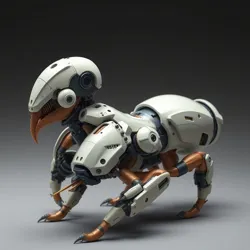Exoskeletal Armor
Exoskeletal Armor is a cutting-edge technology used in the augmentation of various organisms, including the popular GastroMechas, to enhance their durability and defensive capabilities. This innovative system integrates mechanical enhancements with the natural structure of living creatures, providing them with increased protection and versatility in both sports and military applications.
Development and History
The concept of Exoskeletal Armor originated in the early 21st century, spurred by the need for more resilient biomechanical systems. Pioneered by engineers such as Max Shellman, this technology has evolved significantly since its inception. Initially developed for military use, Exoskeletal Armor has found applications in various fields, including GastroMecha racing and defense.
Early Innovations
Early iterations of Exoskeletal Armor were bulky and primarily focused on providing basic protection against environmental hazards and physical impacts. However, advancements in materials science and biomechanical engineering have led to the creation of lightweight, highly adaptable armor systems. These innovations allow for greater flexibility and mobility, crucial for applications like the Grand Prix of Slime, where speed and agility are paramount.
Components and Functionality
Exoskeletal Armor systems are composed of several key components:
- Protective Shells: Made from advanced composite materials, these shells provide a hard, protective outer layer that can withstand significant impact.
- Joint Mechanisms: These allow for natural movement and flexibility, ensuring that the augmented organism maintains its agility.
- Sensory Enhancements: Integrated sensors provide real-time feedback on environmental conditions and structural integrity, enabling quick adjustments during high-pressure situations.

The sophisticated design of Exoskeletal Armor provides enhanced protection and flexibility.
Applications
GastroMecha Sports
In the realm of GastroMecha Sports, Exoskeletal Armor plays a critical role in ensuring the safety and performance of these biomechanically augmented creatures. The armor not only protects against physical collisions during races but also enhances the aerodynamic profile of the GastroMecha, contributing to its overall speed and efficiency.
Military Defense
Exoskeletal Armor is also extensively used in military applications, where it provides enhanced protection for military GastroMechas against various threats. Its ability to integrate seamlessly with the organism's natural systems makes it ideal for deploying in complex and hazardous environments.
Ethical Considerations
The use of Exoskeletal Armor raises important ethical questions, particularly concerning the welfare of augmented organisms. As with other forms of biomechanical enhancement, there is an ongoing debate about the balance between technological advancement and the humane treatment of living creatures. Advocates for ethical innovation stress the importance of maintaining high standards in the development and application of such technologies.
Future Prospects
The future of Exoskeletal Armor looks promising, with ongoing research focused on improving materials and integration techniques. Innovations in energy-efficient design and autonomous control systems are expected to further enhance the capabilities of these systems, expanding their potential applications.
See Also
- The Evolution of GastroMechas
- Grand Prix of Slime
- Profiles in Innovation: Dr. Helix Slugworth
- Military Applications of GastroMechas
- Energy-Efficient Design
- Autonomous Control Systems
Exoskeletal Armor represents a significant advancement in biomechanical engineering, offering enhanced protection and performance for augmented organisms. As this technology continues to develop, it will likely play an increasingly important role in various fields, from sports to defense.